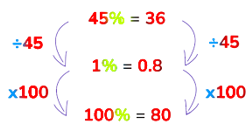About Reverse Percentages
What do you mean by reverse percentages?
Working backwards to obtain an original quantity given a percentage of that amount is known as reverse percentages (or inverse percentages).
- Using a calculator, we can find 100 per cent by taking the percentage we've been given, dividing by 1 percent, and multiplying by 100.
- We can compute this without using a calculator if we use factors from the percentage we were given.
- We are sometimes provided with a percentage of an amount and must determine the original value.
It's important to remember that the original payment represents 100% of the value.
What do you mean by reverse percentages?
Reverse (or inverse) percentages mean working backwards to find out an original amount, given a percentage of that amount.
Example: 45% of a number is 36. Find the original number.
Sol:

- When given a % of a sum, how do you employ reverse percentages? (calculator method)
- Using a calculator, find the original amount given a percentage of the amount:
- Calculate the percentage and multiply it by the amount you were given.
- Subtract the percentage from both sides.
- (For example, if you have 80%, divide both by 80). This will provide you with 1%.
- Both sides should be multiplied by 100.
- This will provide you with 100%.